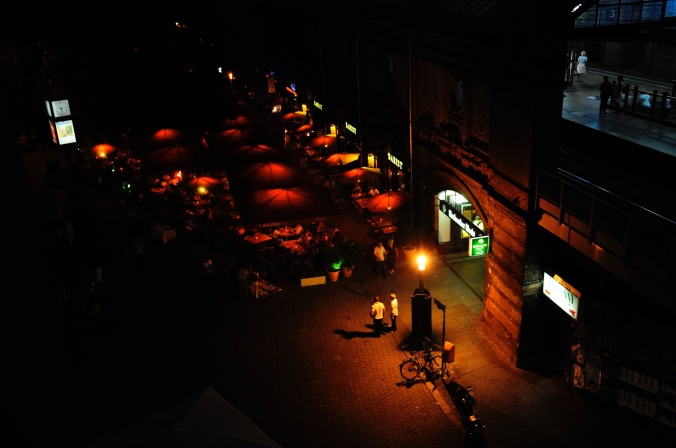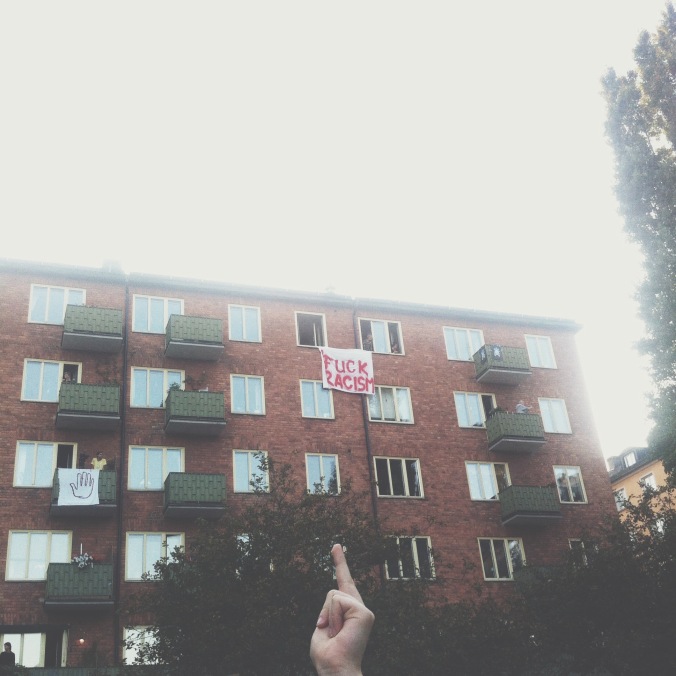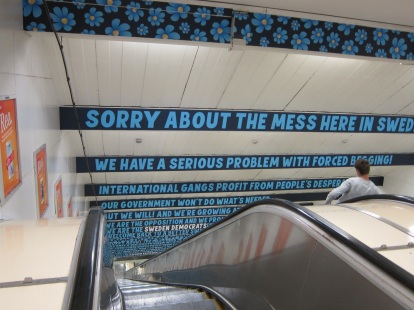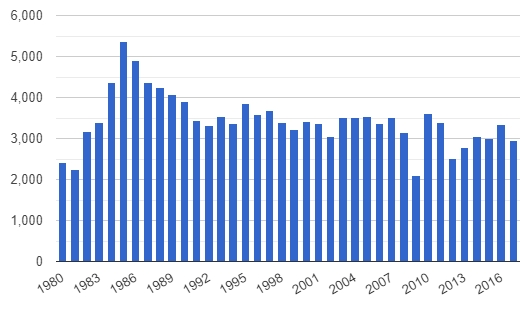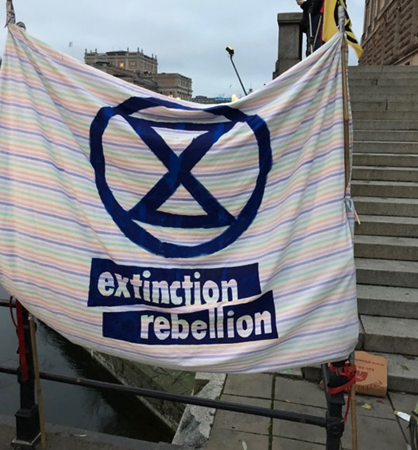The idea that remaining within the EU will automatically provide benefits and resolve problems is a kind of magical thinking. It has ultimately proved dangerous with the evidence being the systematic rise of far Right parties, austerity, a limited system to save and integrate immigrants or prevent the wars or economic disasters which accelerated immigration. Nevertheless, citizens can mobilize nationally via their states and put pressure on the EU. If anything the Brexit vote clearly shows contingency vis-à-vis the European Union.
By Jonathan M. Feldman
The basic problems at hand are the following. First, part of Cosmopolitanism is associated with an anti-racist, pro-migration set of policies. Call that progressive or Left Cosmopolitanism. Second, part of Cosmopolitanism is associated with using migration, free movement of capital, and globalization to break the power of unions and reduce living standards. Call that reactionary or Right Cosmopolitanism. The two are related and partially overlap. In theory, a solidarity system would strengthen the former at the expense of the later, but these systems can’t come from traditional trade union approaches (other than organizing the unorganized) and don’t naturally or necessarily occur within the European Union Framework. Some elements of identity politics and new social movements are perfectly happy with the synergies between Left and Right Cosmopolitanism. They engage in bad faith.
Second, part of Nationalism is associated with racism, xenophobia and the embrace of national capitalism and capitalists. Call this Reactionary Nationalism. Third, part of Nationalism is associated with managed trade, regulations, industrial policy and using the state to control or limit capitalism, advanced public services and needs. Call this Progressive Nationalism. The two are related as even some far Right groups call for national controls over who controls and owns industry. Yet, a nationally-owned industry can sell out its workers just as well as a foreign-owned industry (sometimes the foreign-owned industry is better able to preserve jobs). Some elements of the so-called Trotskyite left engage in a de facto rhetorical alliance that profits from the synergies between Left and Right Nationalism. They too engage in bad faith.
The Political Scarcity of the Left versus Reconstruction
The limits of Cosmopolitanism and Nationalism as paradigms are self-evident, even as each potentially has progressive elements to them. The bad faith illustrated above is part of the problem. Each element of bad faith is based on the politics of scarcity in the political accumulation of capital (be it economic, political or media capital). What is needed is an agenda to support: a) solidarity, b) the disarmament and alternative foreign policy regimes that would limit wars, arms exports fueling them, and hence a fair share of migration, c) the promotion of a sustainable society based on coalitions linking labor, environmentalists, immigrants, the children or grand children of immigrants, peace groups, and some elements of socially responsible businesses, and the progressive elements of the welfare state among other parties, d) economic democracy, media democracy and political democracy based on the ensemble of power that links networks of cooperatives, citizens’ controlled banks, face to face deliberative and media networked forms in a kind of local political space that is integrated regionally, nationally, and internationally, and e) the progressive integration of consumption and production, in which cooperative forms of each sustain one another. Yet, remaining or exiting the EU does not automatically produce these.
The alternative agenda discussed above is what we mean by “Economic and Social Reconstruction.” It is an agenda that embraces economic reconstruction and new forms of democratic engagement based on the use of political organizing, media organizing, the use of a political canvassing system, study circles, and a series of new institutions be they cooperatives, peoples’ universities, alternative banks, consumption federations and multi-product firms making needed alternative energy and mass transportation systems. Reconstruction requires new spatial arrangements, alternative planning regimes and a political engagement with these.
A Plague on Both their Houses
Is Brexit automatically Social and Economic Reconstruction? No, it is not. It is a political platform which far Right groups can easily exploit resulting in a political vacuum generated by leaving the European Union, unless we are talking about the Scottish response which is not Brexit but Scotenter, the Scottish entry into the European Union on its own terms. Does this mean that nationalism is automatically bad? No, as I already indicated there are progressive elements to nationalism in the form of managed trade, (national) industrial policies and the like. The problem is that Brexit involves an unholy alliance between reactionary and progressive Nationalism that basically represents a faustian bargain. It is a faustian bargain because exiting the EU does not automatically promise wonderful things as the political and economic elites can just as well embrace neoliberalism within the EU as outside of it if there is no Social and Economic Reconstruction. Does this mean that leaving the EU does not provide theoretically advantages? No, it does not mean that. Yet, when you Brexit without Social and Economic Reconstruction you basically engage in magical thinking that in my opinion is dangerous, even as I respect elements of the Brexit position.
Is remaining within the European Union automatically Social and Economic Reconstruction? No it is not, it is a political platform dominated by transnational corporations, political elites and forces of neo-liberal capitalism. The idea that remaining within the EU will automatically provide benefits and resolve problems is a kind of magical thinking. It has ultimately proved dangerous with the evidence being the systematic rise of far Right parties, austerity, a limited system to save and integrate immigrants or prevent the wars or economic disasters which accelerated immigration. These wars were partially triggered by U.S. militarism but received some assistance from various EU nations (via arms exports, cooperation with NATO, or reactionary foreign policies that would likely exist with or without the EU).
As we can see, either side of this debate can engage in magical thinking. Either side can claim elements of logic to their side, but neither really can promote the high road for Europe or the global community.
Can we argue that the EU facilitates Social and Economic Reconstruction? There are some research programs within the EU that can do this, but in actuality the constraints placed on independent national state actions are highly problematic. There should be demands placed on the EU to make changes.
Can we argue that the EU cannot be reformed ever and is a dead weight on progressive social and economic alternatives? Can we argue that the EU blocks Social and Economic Reconstruction? There is some truth to this position perhaps, but it may confuse a discursive, political, economic and media space with the forces that control this space. Thus, assuming that an institution like the Democratic Party is always militarist, global capitalist, and the like when the Bernie Sanders campaign showed how to contest who controls that space reveals a kind of dialectical quality to such spaces. Yes, the EU was an elite project and the Democratic Party was not simply an elite project. Nevertheless, citizens can mobilize nationally via their states and put pressure on the EU. If anything the Brexit vote clearly shows contingency vis-à-vis the European Union. Please note this is not necessarily a progressive contingency, with the probability for that enhanced by Social and Economic Reconstruction. Also note that the Sanders campaign (or the Left in cooperation with it) could have done far more to promote Social and Economic Reconstruction as outlined here.
As exiting does not necessarily lead to Social and Economic Reconstruction and could very well empower the far Right (if it had not done this already), one can’t easily argue that remaining in the EU changes the balance of forces within the EU. Even if the elites want to keep the EU as their vehicle does not mean that it is impossible to create alternatives to that vehicle. If the Left really had its act together, pressed seriously for Social and Economic Reconstruction, and mobilized in a variety of ways and then failed to reform the EU, then it would make sense to promote a Lexit, a left-exit to the EU in which the Left dominated the discourse around exit and the creation of an alternative pan-European if not global network supporting Social and Economic Reconstruction. Yet, the Lexit forces of today skipped that stage, engaging in a kind of opportunistic alliance with the far Right. This opportunism was based on some reasoned arguments and a gloss over the failures of the British Left to systematically engage in Social and Economic Reconstruction.
The Detractors and Follow Up Analysis:
More Dead Ends?
I now apply the above ideas by reviewing just two articles related to this whole debate. Let us start with Elliot Murphy’s, “Another Tamriel is Possible: Brexit Proposals vs. Solutions” as published in Counterpunch. Murphy writes that “virtually the entire British political elite is in favour of remaining in the European Union. Aside from a handful of Tory careerists like Boris Johnson and Michael Gove who see a disagreement with David Cameron’s leadership as a way to secure their own position within the party, the forces of reaction and business across the wingspan of British politics are flocking to support the EU.” I am not sure what Murphy’s point is here. The balance of the elite are also against forms of racism, does this make their position less valid? And, Cameron’s attack on London’s new mayor was a kind of racist attack, but hardly consistent with the EU’s line or hardly opposed by embracing the very forces aligned with Islamophobia.
Murphy writes “a vote to Leave would pull the EU in a considerably less neoliberal direction, likely benefiting other European countries – not to the mention the global South, in particular Africa, which has enjoyed a fundamentally exploitative relation with the EU since its inception.” I don’t see any evidence for this whatsoever. It is clear that the Brexit vote potentially pushes the EU in a progressive direction, but not necessarily so. Certainly, it is not so without Social and Economic Reconstruction, in any meaningful extent. Britain enjoyed a long history of imperialism and neocolonialism without the EU if Murphy cared to notice.
Murphy criticizes the AEiP movement as follows: “When Michael Chessum, a major organiser of the pro-Remain ‘Another Europe is Possible’ (AEiP) movement, is questioned about what concrete ‘changes’ he would like to see in EU, he simply dodges the question. Chessum’s behaviour generalises. To my knowledge, not a single supporter of Remain has presented a satisfying answer to the question of how we are supposed to go about reforming the EU.” The answer, however, is rather straightforward. One builds up structures and power outside the EU and applies pressure to the UK state and EU. If after trying to build up such structures and power, reform becomes impossible you have at least three options: a) demand concessions if you gain control over the UK state, b) exit if after gaining power or control over that state, you fail, c) use the base of power you accumulate through Social and Economic Reconstruction to strike the best deal with the EU possible, inside or outside the EU. So, the answer is relatively straight forward. Again, one can consider the endless possibilities associated with the New Economy Virtuous Cycle that usually exceed the imagination of the political left. When the Brexit folks embrace this agenda, then please let me know.
Murphy’s critique of Yanis Varoufakis, Ed Rooksby and trade union leaders in Britain all point to the same failure of imagination by both this group and Murphy himself. So, the failure of imagination is quite ubiquitous. Murphy may understand this as when he writes: “It is not as if another EU is inherently unreachable, but rather that without any posited, realistic steps to achieve it, the hopes of the Remain camp will quickly dissolve after June 23rd, no matter which side wins.” He continues, “Concrete solutions are lacking, then, as it is no good for the Left camp of Remain to simply point voters in the direction of Owen Jones columns and Caroline Lucas YouTube videos instead.”
Murphy continues, “the foundational pro-austerity, market liberalisation principles of the EU are established by the same treaties, which can be modified only by a unanimous agreement by all 28 member states.” This might be true but then we saw how Cameron was able to gain some concessions from the EU despite one state being up against a number of other EU states. What if it was not Cameron, but a Labour Party Prime Minister backed by a transnational social movement? Could he have gotten more concessions? Capitalism with or without the EU represents barriers. Leaving the EU does not eliminate capitalism or Neoliberalism, it just creates a different arena to fight within. But, the fight must be had and is not triggered or generated automatically by Brexit.
Let us now turn to Murphy’s analysis of Noam Chomsky’s arguments: “The Left Remain camp have also recently been galvanised by Noam Chomsky’s tenuous support for their cause, with Owen Jones and AEiP posting quotations of the professor’s brief statements on the matter. Chomsky’s reasons for supporting Remain are extremely weak and don’t stand up to much scrutiny. His reasoning is as follows: The racist Right is in favour of Leave, therefore we should Remain. But the racist Right is also in favour of Remain. Chomsky’s logic seems to be as follows: If P, therefore Q, so why not Z?” Here Murphy engages in bad faith. He does not understand that the discursive moment is largely tied to a right-wing anti-immigrant agenda tied to a reaction to austerity. They are linked. It does not matter that the number of voters supporting exit far outnumber the far Right voters. Why? Because the Far Right has triggered a larger discourse which mainstream parties, particularly on the Right, react to. The media embrace and legitimize large aspects of the Far Right discourse and that influences far more persons than the number of Far Right voters. This discourse is based on the coupling of anti-austerity with Brexit. This coupling is made possible by the failures of the Left as exploited by the Right. Brexit does not decouple anti-austerity and anti-racism. This is Chomsky’s larger argument which Murphy buries.
It is true that a racist and anti-immigrant vote is not the sole driver of the Brexit campaign and many hurt by austerity had what they felt to be good reasons for voting against the EU. Rather, as Billy Bragg explains, this was certainly true and just as true was the fact that the Far Right are net gainers from Brexit. The coupling of anti-austerity and racism is based on the “Socialism of Fools,” or more charitably a kind of false promise that a victory over austerity necessarily simply follows by beating the horse of Reactionary Cosmopolitanism.
Murphy continues by suggesting that Obama’s opposition to Brexit does not mean that a Brexit vote would leave Britain more subordinate to US power. Here again, his logic fails him. First, Obama and the U.S. military industrial complex are not quite the same thing. The former is less powerful than the latter. Obama’s whole election and administration accommodated this power. So, it may be that Obama wants the UK in the EU to bolster something economically (or US blocking a closer Chinese alliance with the UK that would also make the UK that more military dependent on the US) whereas the military industrial complex would gain from Brexit. Look at Germany, economically aligned with Russia on gas pipelines, military aligned with NATO. UK remains in NATO but is outside of EU in Brexit. So, Brexit could benefit the US militarily but not economically, with Obama himself being more concerned with the economic implications. In any case, it is something of an open question and Chomsky is not necessarily wrong.
Murphy correctly points out limitations to the EU: “State aid to declining industries, along with renationalisation, are not permitted by current EU laws (under directive 2012/34/EU), and any mildly progressive government which managed to get elected in 2020 would be hindered from the outset by the EU. Considerable reforms of the energy market would also be illegal under EU directives 2009/72EU and 2009/73/EU.” This is true, but in Sweden the government created a somewhat significant pharmaceutical R&D center for displaced technical workers from that sector and the EU did not block that. The EU did not block the wind energy cooperatives that exit in Sweden either. So, the EU is hardly blocking all the elements of a research-linked industrial policy or progressive aspects of energy policy. Thus, Murphy is correct to point these things out but can’t explain why the Danes who are in the EU have a vibrant wind production sector and thousands of green jobs, whereas UK green job production in some areas is less impressive. Rather, he selectively cherry picks the worst case arguments but leaves out the necessary counterfactual arguments.
Murphy continues to provide negative examples, but does not think them through logically. For example, he writes: “McDonnell’s plans for People’s Quantitative Easing? Outlawed by Article 123 of the Treaty on the Functioning of the European Union.” Does the EU prevent a progressive bank like JAK bank in Sweden? No. Does the EU prevent the organization of millions of left voters to patronize and support this bank? No. Does the EU prevent unions from organizing their members to patronize JAK and use it as a bank to extend industrial cooperatives? No. Over and over, we see how the EU despite its great limitations becomes for Lexit or Murphy the fulcrum of all (or most) of the Left’s failures when it is the Left itself which is most to blame. Or, how Brexit was to be a necessary condition for success, but Brexit’s reactionary pitfalls are papered over.
Here is another Murphy argument: “The series of anti-trade union laws introduced in Britain over the past few decades? The EU has no qualms with these whatsoever, showing no interest in providing even modest forms of protection for workers.” Yes, but this simply shows how British Neoliberalism can thrive even without the EU, thank you very much! Murphy seems to acknowledge as much: “Given the sheer dominance of the traditional forces of international finance on both sides of the mainstream debate, talk of a Lexit or a Left Remain become highly misleading: There will be only a ‘Rexit’ or a right-dominated Remain – at least in the short term.” Murphy acknowledges Chomsky’s arguments later on (creating a puzzling inconsistency): “Brexit will likely boost the anti-immigrant Tory, UKIP and Labour base in the short term.” Nevertheless, he quickly runs over to magical thinking: “Yet over the coming years it will permit a future Labour-run Britain to implement mildly social democratic reforms much more easily, to be otherwise hindered by the EU’s strictures – that is, if Corbyn goes on the offensive and exploits the Tory’s weaknesses to a greater extent than he currently seems willing to do. A Corbyn-led Britain (or at least a Corbynite-influenced Labour Britain) outside the EU would be free from the direct influence of the European Central Bank, which is legally committed to favour deflation and stagnation over growth. Government aid to failing industries is barred…” What if the far Right is empowered at the expense of Lexit? How does Brexit politically empower Corbyn to do anything? There is no natural or logical connection here because this is thinking by non-sequitor.
Recent evidence suggests that Brexit led to divisions in the Labour Party, but only time will tell. Brexit encouraged a revolt in the Labour Party by what some consider the Tony Blair wing of the party, although others point to poll data that suggests that Labour gained at the expense of UKIP and the Conservatives. If UKIP and the Conservatives lost support because of a backlash against Brexit and/or the immediate economic fallout of Brexit, then greater Labour support for these reasons hardly bolsters the case for Brexit. A wave of racist incidents followed Brexit as documented by The Washington Post and The Guardian, which reveals far right opportunism but also the ways in which the discursive space is exploited even if UKIP’s poll numbers decreased. These shifts and turns in British politics might be explained by the lack of political understanding of what the European Union even is, even though voters for Brexit suffering from austerity certainly reacted to that.
We have reason to suspect the non-sequitor when Murphy later writes: “leaving the EU would by no means result in immediately significant changes or wins for the European Left.” The next sentence is telling, “but it would crucially open up an entirely different kind of debate from the one inevitably resulting from a Remain vote (especially given the bizarre fixation of the Remain campaigns – including AEiP – solely on the virtues of the EU, and not its considerable shortcomings). In addition, it would lead to the kind of debate in which leftists would no longer feel compelled to recycle myths about how David Cameron is somehow ‘better’ on immigration issues than Boris Johnson.” What is the problem with Murphy’s logic here? He confuses a discursive shift with the generation of an alternative media platform. Unlike the U.S., with its network of community and Pacifica or radical radio stations, the U.K. lacks any such equivalent. The BBC is under pressure from the Right, further constraining that space. The country is littered with reactionary tabloids. A few bright spots, like The Guardian and The Independent, are often outgunned in media power. Here we see clearly the magical thinking which conflates discursive openings with the hard work of Social and Economic Reconstruction.
Murphy still engages in the kind of bean counting approach to measuring the far Right’s power which I have already criticized. Let us look at one example: “The sight of Johnson trying to lead an increasingly fractured and rebellious party, forced into a number of substantial retreats, would be nothing less than a gift to the entirety of the UK Left.” Here is a confusion between individual politicians and personalities and the larger framework of far Right discursive power. As I stated, the far Right leverages power by its own numbers and by its effects on the other Right parties and (I can now add) by the politics of scarcity, i.e. the Left does not have a comprehensive integration policy for immigrants (linked to cooperatives, efficiency in skills trading and skills banks, facilitating self-organization and the like), and the role played by mass media. While Johnson himself might find problems in ruling the conservatives, that does not mitigate all these other advantages of the far Right. The Brexit victory will be leveraged effectively by a larger network of forces that is far larger than just one politician.
Murphy turns to arguments by Baroness Jenny Jones, a prominent Green Party member, in a Fabian Society essay, “A Fork in the Road.” She writes, “Personally, I fear [the EU] is unreformable…And latterly I’ve been horrified too by the deep influence of big business – corporate lobbyists outnumber NGO lobbyists by 15-1. What chance is there of tough progressive action on poverty or the environment.” This is a very important and interesting argument, but applied to Brexit, it leaves many questions unanswered.
First, does the Left in the UK do everything it could do to increase its political, economic, and media power leverage? No, it does not. It does not create a radical media space to challenge entrenched corporate interests. It does not link its consumptive power to generate cooperatives on the production side whose profits could be used to patronize this media.
Second, by failing to accumulate such power, it does not allow itself to advance a progressive agenda within the potential of its power accumulation trajectory inside or outside the EU.
Third, leaving the EU does not change the balance of power with big corporate lobbyists in any significant way. More tedious and specious mind-numbing logic. Murphy concludes, “a vote for Leave isn’t just a vote against the neoliberal forces of the Troika: It is also a vote against our own ruling classes.” No, it is a vote against the preferences of your ruling class, but it does not and will not defeat them; it will only displace the battles you have with them to new terrains, new terrains where you will lose the battle without Social and Economic Reconstruction.
Paul Mason and Brexit.2
Paul Mason wrote a kind of political obituary for the the UK’s links to the EU in “Britain is not a rainy, fascist island–here’s my plan for ProgrExit,” published in The Guardian. The gist of this article is that the gig is up, i.e. it’s too late to put the pieces together again of a now fragmented British romance with the EU. Mason writes, “We must prevent the Conservative Right using the Brexit negotiations to reshape Britain into a rule-free space for corporations; we need to take control of the process whereby the rights of the citizen are redefined against those of a newly sovereign state.” Mason calls for making the most of the fait accompli of exit: “we can and must fight to place social justice and democracy at the heart of the Brexit negotiations. I call this ProgrExit – progressive exit. It can be done, but only if all the progressive parties of Britain set aside some of what divides them and unite around a common objective.”
While Mason is clearly one of Britain’s most sophisticated analysts of political and economic affairs, there are a few questions one might want to ask about this article.
First, one can ask whether or not Mason understands the limits of majoritarian democracy. Mason writes, “Labour must clearly accept Brexit. There can be no second referendum, no legal sabotage effort. Labour has to become a party designed to deliver social justice outside the EU. It should, for the foreseeable future, abandon the objective of a return to EU membership. We are out, and must make the best of it.” If 48 percent opposed Brexit, the acceptance of the 52 percent who supported are hardly representative of all opinions. In Social and Economic Reconstruction the logic is not based on majorities but critical minorities who attempt to convince and influence majorities. Siding with 52 percent is hardly a sufficient response.
Second, while Mason is correct that the Left has to put its spin on things, we have an interesting situation in which the real winner is the far Right. After all, both the Conservative and Labour Party leaders opposed and UKIP embraced Brexit. Therefore, embracing Brexit objectively aligns one with UKIP’s agenda even as you scramble to come up with a Left response to UKIP. Rather than force something that UKIP has to respond to, the Left’s immediate thought is to react to what UKIP helped set into motion. This means that a Left response is going to partially be reactive, no matter how “proactive” it may seem in design or intentions.
Third, Mason calls for early elections, but here he appears to put the cart before the horse. I have already suggested that political mobilizations without media and economic mobilizations will always be limited affairs. Rather than get the Labour Party on a track to create and implement such comprehensive mobilizations, Mason wants to rush Labour into an election. I don’t understand the logic of such thinking at all. Labour could be organizing the public through town meetings and an ad hoc virtual town hall system of cities using the Internet and progressive media such as exists in the UK. He need not have an election to do this.
Fourth, Labour is in a bind if Brexit leads Scotland to leave the UK. Mason writes, “Labour – which cannot govern what is left of the UK alone, once Scotland leaves – should accede to [proportional representation].” If Scotland’s departure weakens the Left’s political power or possibilities of a political majority within the UK, I don’t see that the natural war of position” as being the electoral route. Rather, to repeat again and again, the natural war of position is in the organization of an alternative economic and media space as well as through a system of direct democracy. Does the UK even have a labor radio network like WINS, the U.S.-based radio network? How does the Left mobilizing for an election or putting a progressive spin on Brexit lead to the creation of such institutions? Answer, they don’t lead to this of necessity.
Finally, while Mason is correct that Scotland is on its way out of the UK or is likely to leave, the real questions for us should rather be the following (none of which Mason takes up): (a) If Scotland leaves the UK, can the new Scottish state create a progressive bank which is aligned with the cooperative banks of Mondragon and banks like JAK in Sweden? Could this bank be used to leverage the creation of cooperatives in Scotland and the balance of the UK? (b) If Scotland creates cooperatives that are part of large networks, could these federations start organizing sustainable industries and work in the areas abandoned by transnational capitalists in England, Wales or Northern Ireland? (c) Can Scotland create a Left broadcasting network similar in format to RT (Russian Television) or Al Jazeera which broadcasts progressive programming into the UK and competes with the BBC from the Left? Are we just going to view Scotland’s decisions as some sort of political variable and leave out all the important questions related to economic, banking, and media power?
Conclusions: The Short-Term, Medium-Term and Long-Term Solutions are the Same
Brexit or Lexit, either way you slice it, we have a victory for the far Right and only a theoretical opportunity for the Left of the UK or Europe. The same magical thinking that always puts a progressive gloss on everything the EU does finds analogous thinking in the magical thinking that assumes that Brexit translates into a stunning defeat for Neoliberalism. Rather, Neoliberalism, simply can shift its attentions to ruling the UK without the EU. There is no substitute for the primitive accumulation of the economic, media and political capital necessary for Social and Economic Reconstruction. Remaining in the EU or exiting the EU does not automatically produce such power accumulation systems on behalf of democratic impulse, autonomy, and the creation of a sustainable society. The Right and Left each search for short cuts. The far Left is totally naive about their capacities and ability to control or manipulate the situation because their deconstructive discourse about the EU is largely divorced from a reconstructive discourse. The far Right have shown themselves clever in manipulating or setting the agenda for the mass media and large electoral blocks by marrying anti-austerity with racist xenophobia. The far Left may try to fantasize itself out of its objective alliance with this unholy marriage by projecting things that they hope they can do, but probably will never accomplish without a far more radical program that they themselves hardly (or ever) embrace.
In summary, staying in the EU or exiting it does not or did not produce the necessary outcomes in and of itself. The far Left commits a tactical error by aligning themselves objectively (but not subjectively) with the far Right. They can’t produce any meaningful anti-imperialist, anti-militarist, or anti-austerity agenda simply by leaving the EU. Either way you look at it (a radical alternative outside the EU or a reformed EU which accommodates reconstruction), you need reconstruction and the agenda outlined in this essay. And guess what? The Left fails over and over and over to give us the discourse we need, with a few notable exceptions.

